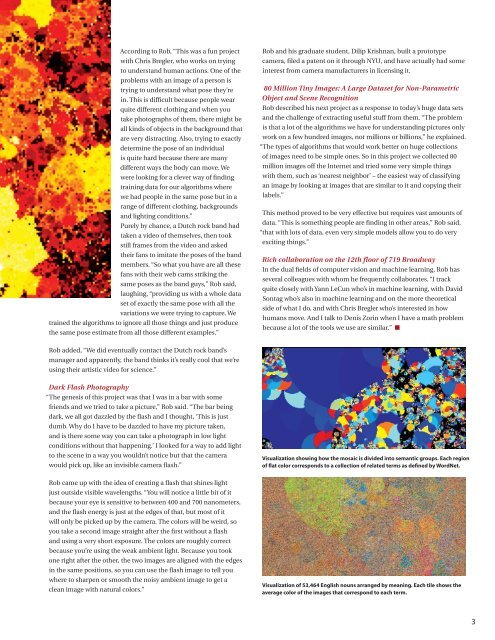Newsletter - Courant Institute of Mathematical Sciences - New York ...
Newsletter - Courant Institute of Mathematical Sciences - New York ...
Newsletter - Courant Institute of Mathematical Sciences - New York ...
You also want an ePaper? Increase the reach of your titles
YUMPU automatically turns print PDFs into web optimized ePapers that Google loves.
According to Rob, “This was a fun project<br />
with Chris Bregler, who works on trying<br />
to understand human actions. One <strong>of</strong> the<br />
problems with an image <strong>of</strong> a person is<br />
trying to understand what pose they’re<br />
in. This is difficult because people wear<br />
quite different clothing and when you<br />
take photographs <strong>of</strong> them, there might be<br />
all kinds <strong>of</strong> objects in the background that<br />
are very distracting. Also, trying to exactly<br />
determine the pose <strong>of</strong> an individual<br />
is quite hard because there are many<br />
different ways the body can move. We<br />
were looking for a clever way <strong>of</strong> finding<br />
training data for our algorithms where<br />
we had people in the same pose but in a<br />
range <strong>of</strong> different clothing, backgrounds<br />
and lighting conditions.”<br />
Purely by chance, a Dutch rock band had<br />
taken a video <strong>of</strong> themselves, then took<br />
still frames from the video and asked<br />
their fans to imitate the poses <strong>of</strong> the band<br />
members. “So what you have are all these<br />
fans with their web cams striking the<br />
same poses as the band guys,” Rob said,<br />
laughing, “providing us with a whole data<br />
set <strong>of</strong> exactly the same pose with all the<br />
variations we were trying to capture. We<br />
trained the algorithms to ignore all those things and just produce<br />
the same pose estimate from all those different examples.”<br />
Rob added, “We did eventually contact the Dutch rock band’s<br />
manager and apparently, the band thinks it’s really cool that we’re<br />
using their artistic video for science.”<br />
Dark Flash Photography<br />
“The genesis <strong>of</strong> this project was that I was in a bar with some<br />
friends and we tried to take a picture,” Rob said. “The bar being<br />
dark, we all got dazzled by the flash and I thought, ‘This is just<br />
dumb. Why do I have to be dazzled to have my picture taken,<br />
and is there some way you can take a photograph in low light<br />
conditions without that happening.’ I looked for a way to add light<br />
to the scene in a way you wouldn’t notice but that the camera<br />
would pick up, like an invisible camera flash.”<br />
Rob came up with the idea <strong>of</strong> creating a flash that shines light<br />
just outside visible wavelengths. “You will notice a little bit <strong>of</strong> it<br />
because your eye is sensitive to between 400 and 700 nanometers,<br />
and the flash energy is just at the edges <strong>of</strong> that, but most <strong>of</strong> it<br />
will only be picked up by the camera. The colors will be weird, so<br />
you take a second image straight after the first without a flash<br />
and using a very short exposure. The colors are roughly correct<br />
because you’re using the weak ambient light. Because you took<br />
one right after the other, the two images are aligned with the edges<br />
in the same positions, so you can use the flash image to tell you<br />
where to sharpen or smooth the noisy ambient image to get a<br />
clean image with natural colors.”<br />
Rob and his graduate student, Dilip Krishnan, built a prototype<br />
camera, filed a patent on it through NYU, and have actually had some<br />
interest from camera manufacturers in licensing it.<br />
80 Million Tiny Images: A Large Dataset for Non-Parametric<br />
Object and Scene Recognition<br />
Rob described his next project as a response to today’s huge data sets<br />
and the challenge <strong>of</strong> extracting useful stuff from them. “The problem<br />
is that a lot <strong>of</strong> the algorithms we have for understanding pictures only<br />
work on a few hundred images, not millions or billions,” he explained.<br />
“The types <strong>of</strong> algorithms that would work better on huge collections<br />
<strong>of</strong> images need to be simple ones. So in this project we collected 80<br />
million images <strong>of</strong>f the Internet and tried some very simple things<br />
with them, such as ‘nearest neighbor’ – the easiest way <strong>of</strong> classifying<br />
an image by looking at images that are similar to it and copying their<br />
labels.”<br />
This method proved to be very effective but requires vast amounts <strong>of</strong><br />
data. “This is something people are finding in other areas,” Rob said,<br />
“that with lots <strong>of</strong> data, even very simple models allow you to do very<br />
exciting things.”<br />
Rich collaboration on the 12th floor <strong>of</strong> 719 Broadway<br />
In the dual fields <strong>of</strong> computer vision and machine learning, Rob has<br />
several colleagues with whom he frequently collaborates. “I track<br />
quite closely with Yann LeCun who’s in machine learning, with David<br />
Sontag who’s also in machine learning and on the more theoretical<br />
side <strong>of</strong> what I do, and with Chris Bregler who’s interested in how<br />
humans move. And I talk to Denis Zorin when I have a math problem<br />
because a lot <strong>of</strong> the tools we use are similar.” n<br />
Visualization showing how the mosaic is divided into semantic groups. Each region<br />
<strong>of</strong> flat color corresponds to a collection <strong>of</strong> related terms as defined by WordNet.<br />
Visualization <strong>of</strong> 53,464 English nouns arranged by meaning. Each tile shows the<br />
average color <strong>of</strong> the images that correspond to each term.<br />
3

















